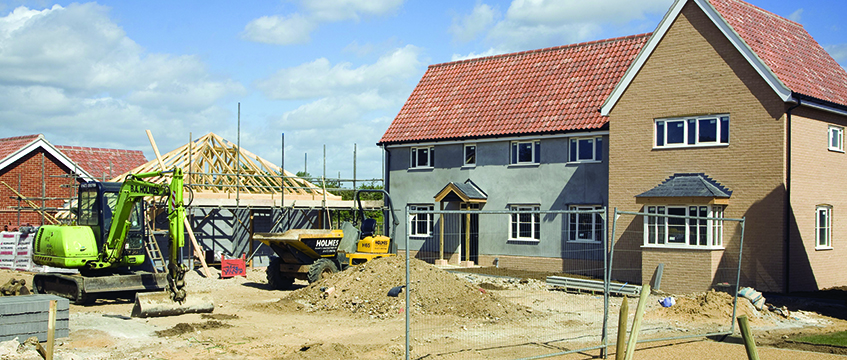Lack of variety biggest barrier to 300,000 new homes target
A range of sizes, pricing and tenancies are needed to boost the number of completed homes, says Savills in its recent analysis of home build rates.
Savills estimates some 218,000 homes were built in 2017/18, significantly lower than an ambitious government target of 300,000. In its “What next for housing delivery” report, researchers examined the gap between housing demand and delivery, ahead of the final recommendations of the Letwin Review, due for release with the 2018 Budget.
Planning consents continue to top 350,000 a year, the National Planning Policy Framework has increased land supply and house price growth has slowed. But Savills predicts marginal increases in house delivery, with the potential to hit 260,000 a year by 2021, and hitting the government target by the mid-2020s.
A range of sizes, pricing and tenancies are needed to boost the number of completed homes, says Savills in its recent analysis of home build rates.
Savills estimates some 218,000 homes were built in 2017/18, significantly lower than an ambitious government target of 300,000. In its “What next for housing delivery” report, researchers examined the gap between housing demand and delivery, ahead of the final recommendations of the Letwin Review, due for release with the 2018 Budget.
Planning consents continue to top 350,000 a year, the National Planning Policy Framework has increased land supply and house price growth has slowed. But Savills predicts marginal increases in house delivery, with the potential to hit 260,000 a year by 2021, and hitting the government target by the mid-2020s.
Initial findings from the Letwin Review released in June argued that landbanking is not the primary driver of failure to deliver homes. Instead the report pointed to the lack of housing diversity playing a major role.
The housebuilding spotlight report builds on this. Savills analysed 30 sites with the capacity for more than 1,000 homes. It noted that housing delivery will only increase if markets become more competitive, and found the most competitive sites with the highest sales rates had a variety of home types and tenures.
Housing type diversity
In the study, the top sales rates were identified in areas with a range of house types (detached, semi-dettached, terraced and flats). The sites with the lowest sales rates tended to have just one housing type, making up more than half of homes delivered. But high variety does not guarantee high sales, there are other factors at play, including variety of house size and local competition.
If new-build completions and sales do not increase, developers will need to consider other areas of the market: namely the private rented sector and affordable homes, which have growing demand.
Build-to-rent
Savills says there is a need for build-to-rent tenancy across the board, particularly in suburban areas with strong employment levels and renter demographics. With house price growth stalling, land value and returns from the growing market of BTR will become more competitive on a greater number of sites, further encouraging growth in this sector.
Market share and pricing
Developers with a higher share of the new builds in a region saw higher sales rates. Sites selling a high numbers of homes tend to be priced in line or below market rates, particularly in less affordable areas. Savills says new homes need to be accessible to the mass market and this requires lower pricing.
Affordable housing
Savills says there is demand for some 100,000 homes a year, either to buy or rent. The report acknowledges government contributions of £9bn towards affordable housing over four years, which is dwarfed by developer contributions. In 2016/17 developers paid £6bn towards affordable homes, but Savills says there is a limit on how much they can pay.
Patrick Eve, head of residential development at Savills, said: “If government is too aggressive in using affordable housing to seek increased developer contributions without providing any additional grant funding, the unintended consequence may be to remove the incentive for land to come forward for housing at all.
“Housing needs to be viewed as vital infrastructure, with grant funding as investment against a future lower benefits bill, if we are to reach delivery targets.”
Savills says achieving the 300,000 homes a year target is possible “with government support and collaboration to bring together public land and capital and private sector expertise to boost delivery”.
The report anticipates that the bulk of homes will continue to be delivered by the largest housebuilders. But their market domination (just 13 companies delivered 63% of homes last year) will be relinquished as smaller housebuilders receive home building funds, and scaled-up housing associations and newly empowered local authorities, which will gain up to £10bn-£15bn through scrapped housing borrowing caps, step up delivery.
In reference to the Letwin Review, Eve says in the report: “The review has been a welcome addition to the discussion around boosting delivery, but ongoing policy support and funding for smaller developers, affordable tenures and infrastructure requirements will be needed to make its aspirations a reality.”
To send feedback, e-mail emma.rosser@egi.co.uk or tweet @EmmaARosser or @estatesgazette











